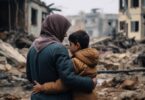There are billions of children living in the world today, many of whom are vulnerable and disenfranchised. Because kids are physically smaller than adults and still developing mentally and emotionally, they face the most challenges from things like poverty, famine, war, climate change and exploitation. Many countries also don’t give children the human rights they deserve. In this article, we’ll go over 20 of the most urgent and serious issues facing kids today.
| # | Issue |
|---|---|
| 1 | Poverty |
| 2 | Hunger |
| 3 | Lack of access to clean water |
| 4 | Death by preventable illnesses |
| 5 | Lack of education |
| 6 | Child labor |
| 7 | Gender-based violence |
| 8 | Child marriage |
| 9 | Early pregnancy |
| 10 | Effects of war and conflict |
| 11 | Exploitation of kids in war |
| 12 | Climate change |
| 13 | Air pollution |
| 14 | Family separation |
| 15 | Human trafficking |
| 16 | Increased risks for LGBTQ+ kids |
| 17 | Racism |
| 18 | Lack of mental treatment |
| 19 | Lack of access to justice |
| 20 | Lack of birth registration |
#1. Poverty
Poverty is one of the most significant issues facing children today. According to UNICEF, around 333 million children live in extreme poverty. While kids only make up ⅓ of the global population, they represent half of people living on less than $2.15 a day. Poverty affects every area of a child’s life, including their health, their access to basic services like clean water and food, their education and much more. Poverty also makes kids more vulnerable to death at a young age.
#2. Hunger
According to Save the Children, 153 million kids are facing food insecurity. While everyone needs food to live, kids are more likely to die from malnutrition and nutrition-related diseases. Around 1 in 5 deaths of kids under five can be traced back to a lack of nutritious food. For those who survive, hunger harms cognitive and physical development. Poverty, climate change, forced migration, and war and conflict are just a few of the drivers of hunger.
#3. Lack of access to clean water
According to 2021 data from UNICEF, around 450 million children live in areas with “high, or extremely high, water vulnerability.” Broken down, this means 1 in 5 kids lack the water they need. This can lead to serious issues, like water-borne illnesses. The World Health Organization lists many diseases spread by contaminated water, such as cholera, dysentery, polio and diarrhea. Children are especially at risk.
#4. Death by preventable illnesses
There’s been significant progress in reducing deaths of kids under five years old, but millions still die from illnesses. In 2021, UNICEF found that 5 million kids under five died, many from preventable conditions like malaria, pneumonia and diarrhea. Vaccines can save the lives of millions of kids, but in 2022, 20.5 million kids did not get life-saving vaccines. This represents a decline from 2019 as factors like the COVID pandemic, supply issues, misinformation and conflict made global vaccination more difficult.
#5. Lack of education
Education access is a human right, but many children don’t get the schooling they deserve. In 2022, the UN estimated that 244 million children between 6-18 years old were not in school. Sub-Saharan Africa struggles the most as it has the most kids and youth out of school. Central and Southern Asia has the second-highest out-of-school population. In better news, the gender gap in education is resolving, though there are still regional differences that need to be addressed.
#6. Child labor
All over the world, children are forced to work in industries like agriculture, mining, domestic work and more. Child labor is a violation of a child’s human rights as it threatens a child’s well-being and health, as well as their access to education. According to UNICEF, more than 1 in 5 kids ages 5-17 years old are forced into labor in the world’s poorest countries. Causes of child labor vary, but poverty is the most common driver. When families and communities live in extreme poverty, everyone – including very young kids – must contribute to the household by working.
#7. Gender-based violence
Gender-based violence (GBV) affects boys and girls, but in different ways. According to Save the Children, violence against girls includes sexual violence, harassment, female genital mutilation, abuse and intimate partner violence. Boys are often targeted for labor trafficking and detention, as they’re seen as violent or a threat to security because of their gender. GBV gets worse during times of conflict.
#8. Child marriage
When a child is forced to marry before age 18, it’s a violation of their rights. For girls, early marriage can lead to social isolation, a disruption of education, career limitations and an increased risk for domestic violence. The impact on boys is less studied, but they face negative effects such as increased career pressure, an increased risk for exploitation and disrupted education. More girls than boys are forced into early marriage; UNICEF estimates that in West and Central Africa, around 4 in 10 girls are married before age 18.
#9. Early pregnancy
In 2022, about 13% of adolescent girls gave birth before they turned 18. Pregnancy before age 18 has a variety of negative impacts. The disruption to education is a major one, as it can limit future economic prospects. Girls who become pregnant young may also face social stigma, violence by family members, forced marriage and serious health issues. The causes of early pregnancy include childhood sexual abuse and early marriage. The social pressure to become a mother can also influence the age at which a girl gets pregnant. In certain societies, early marriage and pregnancy may be the best and only option for a young woman.
#10. Effects of war and conflict
During times of war and violent conflict, children are the most vulnerable. According to UNICEF, over 400 million kids live in countries affected by war and violence. Children also make up half of the civilians killed by landmines and explosives. In many places, violent conflict is escalating. In Ukraine, children are affected by death, injuries, mass displacement and an increased risk of abuse, abduction, human trafficking and sexual exploitation. In the Gaza Strip, half of the 1.9 million displaced people are children, while thousands have been killed or injured.
#11. Exploitation of kids in war
Children aren’t only killed, injured and displaced during war; they can be forced to participate in violence. According to UNICEF, over 105,000 kids were recruited and exploited for conflict between 2005 and 2022. Boys and girls are both targeted for fighting, scouting, cooking, sending messages and sexual exploitation. Armed groups often kidnap kids from their homes and force them to fight, but some join groups to try and earn money for their families. Child soldiers endure both physical and psychological wounds.
#12. Climate change
Climate change harms everyone, but children are especially vulnerable. The United States Environmental Protection Agency lists a few reasons why, such as the fact that developing bodies are more susceptible to things like heat and waterborne illnesses. Kids are also dependent on adults during extreme events, so without an adult’s help, they are very vulnerable during floods, hurricanes, tsunamis and other disasters. UNICEF estimates that around 1 billion kids (which is nearly half of the world’s 2.2 billion children) live in one of the 33 countries considered “extremely high-risk” for climate change impacts.
#13. Air pollution
Air pollution damages everyone’s health, but children are especially vulnerable. The World Health Organization lists six main reasons, including the fact that children’s brains are still developing, their bodies are less effective at managing toxins and they breathe in more air per unit of body weight than adults. According to data, air pollution could be causing over 1,200 deaths of kids under 18 in EEA member and collaborating countries every year. Things like traffic, heating and industry cause the most air pollution. Because children can’t vote on air pollution policies, adults must take steps to reduce air pollution and protect kids.
#14. Family separation
A variety of things can separate families: natural disasters, trafficking, war, poverty and migration. It’s difficult to know exactly how many kids experience separations, but at mid-2023, 110 million people were displaced. Many of those individuals are kids, and family separation is often a result of displacement. Kids separated from their families suffer severe psychological and emotional effects that can follow them the rest of their lives. According to a PBS interview with developmental psychologist Hirokazu Yoshikawa, family separations can even cause impaired memory, reduced auditory processing and an increased risk of physical disease.
#15. Human trafficking
Human trafficking is an illicit practice and therefore hard to track accurately, but data suggests kids make up 27% of all trafficking victims. Both boys and girls are targeted, but boys are less likely to be identified. They’re also more likely to be forced into labor or recruitment by armed groups, while girls are more likely to be sexually exploited and forced into marriage. Children who are trafficked endure physical, sexual, emotional and psychological injuries, many of which extend into adulthood.
#16. Increased risks for LGBTQ+ kids
LGBTQ+ kids face the same vulnerabilities as kids who aren’t LGBTQ+, but their risks are often increased. According to the CDC in the United States, LGBTQ+ young people face higher health and suicide risks than their peers. Around 43% of transgender youth were bullied at school, while 29% attempted suicide. Expanding out to the rest of the world, about 64 countries still have laws criminalizing homosexuality, while discrimination can affect a person’s ability to access healthcare, get a job, get housing and so on. LGBTQ+ kids can see how people like them are treated and face significant mental health challenges.
#17. Racism
Racism places extreme stress on the human body, while racial discrimination also affects a person’s access to good healthcare, housing, food, education, work and so on. According to Harvard’s Center on the Developing Child, Black, indigenous, and other people of color have worse health issues and shorter lifespans than white people across all income levels. This affects every member of a family or community, including children. One study even found that childhood stress caused by traumas like poverty and racism can change the structure of a child’s developing brain. To protect children’s rights, societies need to address racism.
#18. Lack of mental health treatment
Children go through a lot of changes in their adolescent years, which makes them more vulnerable to mental health struggles. According to UNICEF, about 1 in 7 kids experienced a mental disorder in 2019. Depression is very common for kids aged 10-19 years old, while self-harm is among the top causes of death. Without proper treatment, kids can experience serious issues that affect adulthood, including their job opportunities and health.
#19. Lack of access to justice
Children deserve legal rights, but many countries fail in their duty to provide kids with access to justice. According to UNICEF, law enforcement officials deprive over 1 million kids of their rights to liberty. Once in the justice system, kids are often not given the education or resources they need to contact a lawyer, access money for legal fees or get other necessary support. Kids who witness crimes or who are victims of crimes like trafficking are often oppressed, as well. As human beings, kids should be treated equally under the law.
#20. Lack of birth registration
Birth registration is an official record of a child’s birth. It is a human rights matter because birth registration proves the existence of a child, establishes who their parents are and helps ensure a child’s other rights are respected. According to UNICEF, birth registration has increased over the years, but around 1 in 4 kids worldwide are not registered. Reasons include expensive fees, penalties for late registration, long journeys to registration facilities and a lack of knowledge about how to register a birth. Affordable, accessible birth registration is a vital part of protecting the rights of all children.












